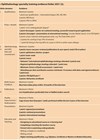Ophthalmology specialist training (OST) is a fantastic career option, however, it is also a highly competitive specialty. There was a gradual rise in competition ratios in recent years: 3.24 (2019), 5.73 (2020), and 6.80 (2021) [1].
Many choose to pursue ophthalmology at undergraduate level, affording them enough time to collect the required evidence for the portfolio assessment [2]. The difficulty lies at postgraduate level, where applicants who have chosen to pursue ophthalmology at a later stage may lack the time to accumulate the necessary evidence [2]. This is further pressured by the demands of the foundation programme (FP). This can result in some candidates falling short of the threshold to secure an OST position and requiring a year out of training, or an elective career break. This is often referred to as a foundation year 3 (FY3), or clinical fellow year [3]. In reality, this year out can drag on for longer than just a single year with subsequent attempts at the OST programme. This is my opinion on the top five jobs that an aspiring ophthalmologist can do during this elective career break to edge closer to the goal of securing an OST number.
1. Educational & Teaching Fellows
These posts are becoming increasingly popular as there is a growing interest in medical education [4]. The role of an educational fellow is tied closely with the local goals of the affiliated medical school. Commonly, in ophthalmology it involves delivering teaching sessions that contribute directly to the undergraduate clinical ophthalmology attachment. Sometimes these roles come with a mix of other job responsibilities, including clinical duties and research [5].
Another example of an educational post is an anatomy demonstrator, although it is more popularly sought by aspiring core surgical trainees. These are often advertised publicly for clinicians or can be enquired about internally through your local affiliated medical school. Despite the subject of anatomy being broad, there are many useful topics, such as neuroanatomy and head and neck, that prove useful to an ophthalmologist.
Example(s):
A. Educational Fellow, The Royal Free London NHS Foundation Trust [5].
B. Anatomy Demonstrator, Brighton and Sussex Medical School [6].
Advantages:
- Opportunity to learn ophthalmology content through teaching.
- Ability to undertake additional funded degrees (PGCert Clin Ed / Med Ed).3. Develop the Education and Teaching Section for OST applications [2].
Disadvantages:
- Often full-time roles that provide less flexibility.
- Moderately competitive, especially educational fellows in ophthalmology.
- Delivering educational sessions alone is not always the highest yield for points (see Evidence Folder, Section 9) [2].
2. Research Fellows
Ophthalmology remains a highly academic specialty, and this is recognised with protected time during training to conduct audits and research projects. There are the occasional research posts that crop up at a junior level, often advertised by large academic ophthalmology units (e.g., London, Newcastle, Southampton) and the chief investigators who attract funding to these units. Sometimes it may be worth approaching the academic units directly to see if there is a salaried position coming up. If a candidate is truly forward-thinking, then a research fellowship can be organised de novo with the appropriate funding and supervision via the National Institute for Health Research (NIHR). There are numerous schemes worth exploring, including pre-doctoral fellowships, however these schemes are often themed, with a specific focus that might not appeal to a prospective candidate [7].
Example(s):
A. Research Fellow in Retinal Disease Models, University of Southampton [8].
Advantages:
- Exposure to ophthalmology research and early career networking.
- The potential for academic output (see Evidence Folder, Sections 6, 8) [2].
- Potential exposure to clinical skills in specific research (e.g., slit-lamp for age-related macular degeneration studies).
Disadvantages:
- Posts at a junior clinical level are rare (most are for post-doctoral level).
- Competitive to secure research funding alone (unless good academic record).
- If research does not excite you, then this will be a cumbersome post to do full time.
3. Ophthalmology Clinical Fellow, Trust-Grade & LAT Jobs
These can be a little bit difficult to find. However, they do exist if enough searching, and asking around, is done. LAT (locum appointment for training) in ophthalmology are even rarer to find, but these posts come with formal accreditation to specialist training [9]. This means that if you complete a LAT at ST1 level and enter OST the subsequent year, you might be eligible to start at ST2 level rather than begin again from the start. Irrespective, all three options are popular since they provide opportunities for more exposure to ophthalmology, which is beneficial for building up an evidence portfolio [2]. Often these posts are advertised through word of mouth, or via the NHS jobs website. Clinical fellow and trust grade posts are often focused on service provision and may not have surgical lists.
Example(s):
A. Ophthalmology Clinical Fellow, Glasgow, NHS Scotland [10].
Advantages:
- Provide high-yield clinical ophthalmology exposure.
- Opportunity to undertake extracurriculars (see Evidence Folder) [2].
- Supportive network to apply for the next round of ophthalmology selection.
Disadvantages:
- Difficult to find and geography dependent.
- Competitive on application.
- Less training opportunities compared to protected trainees and often fulfilling service provision roles (e.g., less surgical lists, more clinics).
4. Allied Junior Clinical Fellow Jobs
Junior clinical fellow jobs are rising in popularity as many trainees either require more time to decide on a training pathway, or have not gained adequate exposure to a specific specialty during the foundation programme [3].
As discussed above, there are few ophthalmology-specific clinical fellowships at a junior level, often most units want an individual for higher subspecialty fellowships. However, this does not close the door on allied clinical fellow jobs that might provide translational knowledge to an aspiring ophthalmologist. These include medical clinical fellow jobs in rheumatology (ocular immunology exposure) and endocrinology (diabetes management exposure), or surgical fellow jobs in ear, nose and throat (practical procedure exposure). Many of these posts now come in both six-month and 12-month attachments, meaning that there is an opportunity for some flexibility with respect to travel, or respite from training.
Example(s):
A. No examples can be provided at this current moment due to the high turnover of jobs. The best places to search include NHS Jobs and indeed.com [11,12]. Once an account is created, you can create email reminders with specific job search terms (e.g., ophthalmology).
Advantages:
- These roles may be combined with other opportunities (education, simulation).
- Learn translational knowledge that is applicable to ophthalmology.
- Stability and security with regards to appraisals and supervision.
Disadvantages:
- Requires some creativity to gain direct ophthalmology value.
- Advertised jobs may be linked to specific specialty, but role can change based on service provision demands (e.g., rheumatology)
5. Locum Job
Last, but not least, is the locum role. This is a highly underestimated role, but one that could pay the most dividends. At a junior level, this will most likely be clinical work that is not ophthalmology orientated and geared around jobs that you have done during the FP. However, during the locum role, one can potentially forge connections with a local eye unit and apply for a non-salaried honorary fellow status to help support any ophthalmology endeavours required during the year. This honorary fellow status allows you to be recognised when attending eye clinics, the eye emergency department and conducting projects. The salary earnt by locums will offset the voluntary work conducted as part of building your portfolio for ophthalmology. There are many guides worth exploring about the locum year, depending on your goals [13,14].
Example(s):
A. Messly [14].
B. Locum’s Nest [15].
Advantages:
- Significant flexibility, allowing to plan your own agenda for clinical shifts and projects.
- High earning potential, depending on the goals of the year.
- Ability to forge a relationship with your local ophthalmology unit.
Disadvantages:
- Unpredictable shift patterns.
- Payment issues depending on the local trust.
- Less support with appraisals and educational supervision.
Summary
From a candidate who was unsuccessful in getting in the first time, I wish all prospective candidates good luck with the process. Although it is a stressful time, I would try to not get disheartened if your attempts for an OST number are unsuccessful; the year out will lead to invaluable experiences, more maturity, and a clearer goal from life when you finally succeed in OST application. Remember, rejection equals redirection. In addition, the above is just a selection of opportunities available to an individual. It is also worth considering roles in medical technology firms, start-ups, pharmaceuticals, management, and leadership positions. Circumstances will vary depending on the needs of the individual and different opportunities will crop up on a year-by-year basis. My main advice going forward is – decide on the goal of your year out, and how it relates to a successful OST application, then choose the areas you need to focus on: exam preparation, portfolio building, or interview skills.
References
1. Health Education England. Specialty Training Competition Ratios.
https://medical.hee.nhs.uk/
medical-training-recruitment
2. Severn Postgraduate Medical Education. Ophthalmology Evidence Folder.
https://severndeanery.nhs.uk/recruitment/
vacancies/show/oph-st1-2022/evidence-folder-lib
3. Raha A, Heminway R. The clinical fellows project: emergence of the FY3 year? BJPsych Bull 2020;44(2):85.
4. Marshall AL, Thompson CA, Cullen MW, R et al. Medical education interest, exposure, and career planning in subspecialty trainees. Med Sci Educ 2020;30(3):1011-4.
5. Khadem N. Ophthalmology clinical teaching and research fellowships: a pathway into ophthalmology specialty training. Eye News.
https://www.eyenews.uk.com/features/
ophthalmology/post/ophthalmology-clinical-teaching
-and-research-fellowships-a-pathway-into
-ophthalmology-specialty-training
6. Smith C. Become an Anatomy Demonstrator. Brighton & Sussex Medical School (BSMS).
https://www.bsms.ac.uk/about/
anatomy-lab/index.aspx
7. NIHR. NIHR Fellowship Programme.
https://www.nihr.ac.uk/explore-nihr/academy
-programmes/fellowship-programme.htm
8. University of Southampton. Clinical Research Fellow in Ophthalmology. Medical Schools Council (MSC).
https://www.medschools.ac.uk/
university-of-southampton/clinical
-research-fellow-in-ophthalmology
9. Watson A. What is the difference between a LAT post and a LAS post? BMJ 2004;329(7479):s236.
10. NHS Scotland. Clinical Fellow in Ophthalmology.
https://apply.jobs.scot.nhs.uk/displayjob.
aspx?jobid=39420&source=JobtrainRss
11. NHS Jobs. NHS Jobs | Candidate Homepage.
https://www.jobs.nhs.uk/
12. Indeed.com. Job Search | Indeed.
https://uk.indeed.com/
13. Kamp J. The Ultimate UK Locum Doctor Guide | Commonwealth Doctors. Commonwealth Doctors.
https://commonwealthdoctors.com/
uklocumdoctorguide/
14. Kurwie C. How To Make A Living as a Full-Time Locum Doctor | Messly. Messly.
https://www.messly.com/blog/how-to-make
-a-living-as-a-full-time-locum-doctor
15. Locum’s Nest. Your total workforce solution.
https://locumsnest.co.uk/
[All links last accessed April-June 2022].
COMMENTS ARE WELCOME









